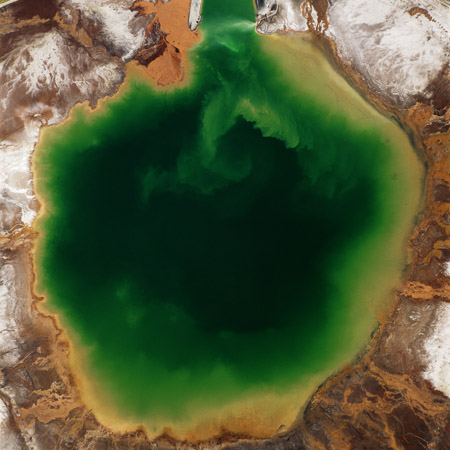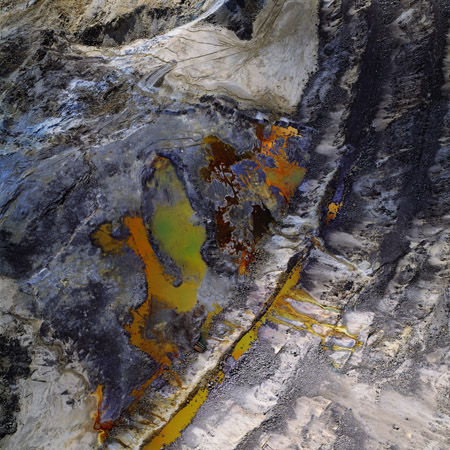 |
Anthropologists say that if you want to learn about a civilization, look at what it leaves behind. David Maisel adheres to that credo. But unlike anthropologists who inspect physical evidence on the ground, Maisel makes photographs of the earth from airplanes, and the geochemical haloes he commits to film – residue of the industrial processes that fuel the human market economy – yield a strange, beguiling kind of forensic evidence. That evidence, assembled in this show and in a stunning new career-spanning book, Black Maps: American Landscape and the Apocalyptic Sublime, forms a kind of planetary autopsy, a portrait of mankind’s ravenous appetites and their consequences. Maisel's use of the word sublime” harks back to 18th century philosopher Edmund Burke who postulated a vision of the natural world that, for humans, elicited two reactions: awe and terror, both of which, in Burke’s conception, were closely intertwined. He arrived at it at a time when American technological know-how hadn't really begun to subjugate the frontier, so there was still plenty to be feared from nature. Over time, both the awe and the terror diminished. But now, more than 250 years later, thanks to greed, hubris and technology, they’ve made a steady resurgence, inviting a wrath far more devastating than anything Burke could have imagined. Which is where Maisel steps in.
.jpg) |
This exhibit, consisting of 10 large-format color images and three small black-and-white images, is a core sampling of the artist’s work from mid-1980s to 2007. At the beginning of this period he worked exclusively in black-and-white, and the results were more topographic than toxic. While the spiraling contours of the open pit mines he pictured inspire awe, they deliver little of the terror seen in, say, Sebastiao Salgado’s or Edward Burtynsky’s photos, where the environmental and human toll is either explicit or implied. That changed in 1989, when, with the proceeds of an NEA grant, he began hiring pilots and switched to color film. The work became abstract. He dispensed with horizon lines and focused instead on details, so that scale and vantage point became almost indecipherable. The artist’s square-format Hasselblad camera helps, too. The format defies the conventions of landscape photography and, by extension, the means by which we orient ourselves in the act of looking at a picture. Result: Maisel’s photographs have no top or bottom. As in Richard Diebenkorn’s air travel-inspired abstract paintings from the early ‘50s or, to take a current example, Leslie Shows’ collages, which are based on mine-scarred Alaska, color becomes composition — but with one critical difference. Where content in Abstract Expressionism springs from the associations we pull from painterly gestures, the plastic activity in Maisel’s photos points to actual facts: the toxic reality of the ground beneath his camera. If his images seem otherworldly, that is because we’ve polluted the world to a point where substantial portions of it have become unrecognizable.
 |
In this show, several images — two of a mining operation in Butte, Montana and three of the Carlin gold deposit in Nevada – illustrate the inability of knowing that he speaks of. In the latter group, Butte, Montana # 7, shows an open pit glazed in an iridescent sheen of blue and gold. At the bottom, swatches of amber-tinged liquid converge like clouds of ectoplasmic vapor. In another photo from that series, Butte, Montana #3, we see recognizable traces of a ravaged mountaintop. Its flattened contours are etched by radiant slurries of yellow, gold, and chartreuse — colors commonly seen in tropical birds, not in the American West. Likewise, Maisel’s shots of Carlin, had they been made black and white, might be taken for seascapes were every element in them not poisoned. The most arresting picture in that group, Carlin, Nevada 1, has, at the center, a glowing emerald pool ringed by cloudy plumes. As with all of his pictures, chemistry, location and the polluter’s identity go unnamed.